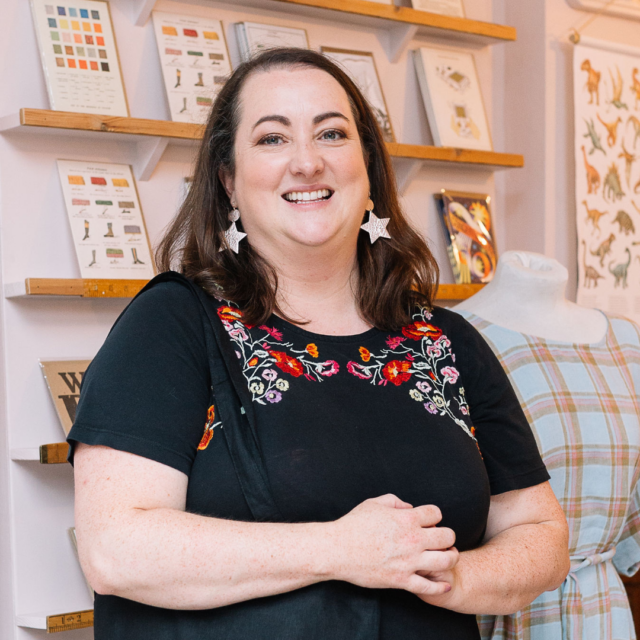The Second Golden Rule of Stock Management
Catherine Erdly: How well are you managing the most valuable asset in your business? In other words, your stock. The chances are, if you are a product business owner, whether that is an e commerce brand or an independent retailer, then the majority of your money, the majority of the value in your business is tied up, the financial value, I should say, is tied up in your stock.
I would put really good money on that. And my question to you is how well are you managing that asset? Last week I was asking the question, do you have a cashflow problem or a stock management problem? And that’s something that I’d like you to ask you again this week based on what we’ve talked about in the last episode, what are your thoughts.
Hi, I’m Catherine Erdly. I’m your host, as well as the founder of the Resilient Retail Club, which is my membership group and mastermind for product businesses. You’re listening to episode number 193 of the Resilient Retail Game Plan podcast. If you missed last week’s episode number 192, then do go check it out because I’m doing a mini series of three episodes all on the subject of my favorite topic which is stock management.
Welcome to the Resilient Retail Game Plan, a podcast for anyone wanting to start, grow or scale a profitable creative product business with me, Catherine Erdely. The Resilient Retail Game Plan is a podcast dedicated to one thing, breaking down the concepts and tools that I’ve gathered from 20 years in the retail industry and showing you how you can use them in your business. This is the real nuts and bolts of running a successful product business, broken down in an easy, accessible way. This is not a podcast about learning how to make your business look good. It’s the tools and techniques that will make you and your business feel good.
Confidently plan, launch and manage your products and feel in control of your sales numbers and cashflow to help you build a resilient retail business.
Last week We talked about the importance of knowing how much stock that you have and this week I want to share with you my second golden rule. But before we dive into the golden rules, I do just want to remind you that if you take a moment to rate and review the podcast or leave a five star review.
However, you can do it in wherever you’re listening to a podcast and it makes a huge difference to getting the podcast out to more people. And of course, if you like, follow, subscribe, whatever the word is for the platform you’re using, then you’ll be the first to know about every new episode that comes out each Thursday morning.
The Second Golden Rule of Stock Management – You need to know what is stock is selling and which is not
Catherine Erdly: So the golden rules of stock management, we’re onto part two. As I mentioned last week’s episode was all about knowing how much stock to have. So do go back and give that a listen if you missed it. But what I want to talk about today is my second golden rule of stock management. And that is be really clear about what’s actually selling and being productive in your business versus what isn’t selling and is sucking up all of your cash.
A stock plan is a good place to start, but it won’t tell you the full story…it has a major flaw
Catherine Erdly: So a stock plan, which is what we talked about last time where you go through you have a look at what you’re going to be selling and what your ideal closing stock is at the end of the month and use that to drive out a budget of how much money you’ve actually got to spend each month.
That is an absolutely fantastic place to start and it will keep you out of trouble in many, many ways. However, it is not the full story when it comes to stock management by any means. It has one major flaw and the flaw that it has is that when you look at your stock like that from a top line perspective, when you look at one single number for your ideal closing stock, what you’re not seeing is all of the different nuances where there could be fast turning stock or slow turning stock, but you can’t see the difference.
So you may have things that are bestsellers for you, that they’re absolutely brilliant products that you know that you must have in, in order to generate sales. But you may also have all of your stock numbers cluttered up by all of this other stock that isn’t selling. And if you don’t split the two out, then you can’t really see the difference.
You can only see this top level number that’s telling you that you maybe don’t have any budget this month, or you have very little budget because overall you’ve got too much stock.
So knowing, how much stock you should have is a fabulous place to start. It already puts you several steps ahead of what lots of other people are doing and it also will keep you out of a lot of trouble when it comes to avoiding too much stock tied up.
However, what you really need to partner this with is understanding what’s productive within that number and what’s unproductive.
And here’s how we fix that flaw, by looking at the tail.
Catherine Erdly: So how do you do that? Well, I like to start by talking about the tail.
So going back to my book, Tame Your Tiger, how to stop your product business eating you alive.
I talked about the bite, which was the profit margins.
I talked about the stomach, which is the overall amount of money that you’re spending in your business.
But then I also talked about the tail, which is what is known as the unproductive stock.
And it goes back to the 80/20 principle, also known as the Pareto principle, which is that 80 percent of your sales are most likely to be coming from 20 percent of your products.
And I’ve run this analysis for lots and lots and lots of different retailers. And I can tell you, it holds true for retailers big and small that 80 percent of sales will be coming from if not quite just 20 percent of stock, it will be coming from somewhere between 20 to 35 maybe 40 percent of the stock. Is generating 80 percent of the sales and that means that you’ve got your stars, your best sellers, the things that are really making a difference for you, but you’ve also got your tail.
So your tail is that unproductive 80 percent of your stock, which collectively is only generating 20 percent of your sales.
And that is the bit that eats all of your money. In fact, one of my favorite sayings from the book is the bigger the tail, the bigger the tiger. So in retail speak, that unproductive. Long tail, as it’s known, is, is the bit that is the 20 percent of sales from 80 percent of your stock and the bigger that tail, the more stock that there is in your tail, then the bigger your tiger, in other words, the more unmanageable your business feels.
So if you feel like you’ve got a problem with cash flow, If you feel like your business doesn’t have enough money in it, go and check how big of a tail you’ve got. Go and check how much money in retail value is sitting in that stock that isn’t really producing much in the way of sales. So that is really, really key.
When you’ve got that in combination with your budget, it’s, it starts making a big difference because you not only have a really clear idea of the amount of money that you want to be spending, but you also have the idea of what it is within that that’s actually making a difference, what it is that you need to be focusing that money on and what it is that you need to be pulling back from.
Knowing what is selling and what is not has other benefits to your business too
Catherine Erdly: The third point I want to make about this is that your best sellers and worst sellers tell you a huge amount. So if Yes, run the analysis. You want to kind of really get a great a good grip on the products that are driving the sales And the products that are just eating up the cash. And as I said the best place to start in order to free up cash in your business Is to reduce the amount of stock that you’re holding in that tail. That is my number one tip to improving your cash flow but the other thing that I want you to do is not just run the numbers willy nilly and have a look at it and just go right.
Okay. Now I understand what it is. Really delve into what those products are. There’s some really useful questions to ask yourself are listed out in the book. when it comes to looking at your best sellers and worst sellers, but they’re basically things like, why do I think this is selling well? What is it about this product that the customer is really responding to?
Do they like the price point? Do they like the color? Do they like the fabrication? Do they like the size of it? The ease of use? Is it really solving a specific problem for them? What is it telling you? And this question is one that you can ask yourself over and over again, and it’s. Something that was really drummed into us.
When I worked in big corporate retailers, we would constantly constantly be looking at the products and asking ourselves those questions and looking at the data for answers and looking at the feedback from customers as well to get a really good idea of what’s going on. So you want to know not just what it is that’s moving the needle, but to the best of your ability, you want to ask yourself why it’s doing that.
For example, one time we looked at all of the worth selling dresses in the department that I was managing, and when we actually wrapped them all up, you could see that they were all green. And it wasn’t until we’d done that, that we realized that that was just a color that that particular color wasn’t particularly hitting home and it helped us be really critical about, okay, what have we got coming up?
Is there anything that we need to do? Any changes we need to make? And even for future development, looking at this color palette, is there any reason why this isn’t working? So you need to learn the lessons from the data. It’s not enough to just run the analysis and have it in front of you. You want to kind of get a good grip of why this is happening.
The next point I wanted to make is you want to, so, so the kind of, so the gold standard for stock management, know how much stock you should have, have yourself a stock plan, be using that stock plan, which we’ll touch on in the next episode more about how you actually use it on an ongoing basis, but actually have it, use it, look at it, use it to create a budget, use it to influence your purchasing behavior as a business owner.
Within that, understand that this, that where you’ve got a certain ideal stock number, there’s going to be some stock that’s working really well and some stock that isn’t. So get really clear on that and get really honed into what’s working and why.
Making a stock plan that gets to product types to understand even more
Catherine Erdly: The other thing that I would recommend that you do is what I call a stock to sales ratio.
So this is something that’s actually touching, I think I touched on it very briefly in the book, but this is something I actually do a lot with the mastermind participants in my mastermind, because it’s really, really interesting and useful when it comes to looking at your stock. You want to look at your best sellers?
Absolutely. You want to look at your worst sellers? Absolutely. But sometimes you need to zoom out from that even more. Some people will actually go ahead and create a stock plan by product type, which is fantastic. And it is really a really great place to get to, if you possibly can. Basically what it means is, is that each different product type that you have in your business, you can have a stock plan directly for that.
So it’s really helpful. For example, if you have seasonal goods, you could do yourself a Christmas decorations stock plan that tells you when you need to buy christmas decorations and how much, or for example, school uniform, you could have one that plots out exactly how much you need to buy when in order to meet this very specific seasonal demand.
But then you could also break it out and have different stock plans for different product types to really help you understand, okay, maybe you are, for example, a lifestyle store and you might have. some fashion accessories that turn really quickly, but you may find that your fabric offering if you offer fabric is turning really slowly.
So if you’re able to look at those separately then you are able to start to understand the nuances of the different types of products in your store and how they react. If you’re not going to get all the way to creating a stock plan by product type, which you know It’s definitely not for the faint of heart
If creating a stock plan by product type is overwhelming – then try a stock-to-sales ratio
Catherine Erdly: Then what I also suggest is something called a stock to sales ratio.
And that is where you, by looking at all of the different product types in your business and compare how they’re selling the sales mix compared to their stock mix.
So for example, let’s say, let’s go back to the idea of somebody who is a, is a lifestyle store. Let’s say that they look at home fragrance.
And in the last month home fragrance was 15 percent of their sales, but it was only 5 percent of their stock Then that’s a really good indicator that they’ve got That they could stand to have a bit more home fragrance for example. And this is a really great exercise coupled with your stock budget because the two things together can mean that you can understand number one How much money you’ve got to spend on your stock and number two which particular product areas It needs to go into.
And that in itself, if you can get those two things working together, then that is huge. That is not just one step ahead of what most people do. It’s probably five to 10 steps ahead. So that’s what I really want you to be thinking about. How much stock should I have? What’s working? And then also which product types.
Now there’s Probably a load of background work to do on this because most people when they set up their businesses, they don’t think about right What how many product types have I got? Do these all make sense? Are they all really logical? Then you may just have categorized things as it seems reasonable so you may have a candles and a diffusers product type and a wax melts product type , and you could, for example, have 80, 200 product types in your business, which makes it really hard to look at this kind of analysis.
I would suggest if you can have more like eight to 10 different product types, categorize all of those different types of candles, wax melts and reed diffuses into home fragrance, then you start to get a really good sense of the overall business units, if you like, that are making a difference to your sales, and it helps you really dig into and understand where you’ve got too much stock.
So all of this is helping you really pinpoint areas of access stock, and by selling through those, you are able to free up the cash in your business.
This is what you should be doing
Catherine Erdly: So, that is my second golden rule of stock management. It is not only know how much stock you should have, but really understand in more depth about the stock that you do have and how it’s performing.
So, a stock plan is a great start, it’s not everything. You really do need to dig in and understand your tail. Don’t forget that your best sellers and your worst sellers tell you a huge amount.
And if you can, get yourself a stock to sales ratio. Stock Plans and Retailers.
The retailers that we used to run stock plans for, they were hugely complex and they were often printed out on A4 in tiny, tiny little numbers and they were all done on a weekly basis and there were so many different numbers that we were looking at constantly to balance all of these millions and millions of pounds worth of stock.
You absolutely do not need anything like that, to that degree. However, if you can get to the point where you know what your budget is for each month and the product areas that you should be spending it on in order to have the biggest impact and have the biggest sales boost because you’re leaning into the product areas that are working and pulling back from the ones that aren’t. Then you are going to be far ahead of the vast majority of people.
So there you go. That is my second rule. Understand not just how much stock you’ve got, but what kind of stock you’ve got and what, needs to be tackled and what you need more of and what it’s telling you fundamentally about what your customer wants to buy from you.
If you want to know more on this topic, again, you can check out Tame Your Tiger, the book. You can also head over to the Resilient Retail Club and take a look at the Tame Your Tiger course in there. We’ve got lots of detail about how to do your 80/20 analysis, including video explainers and templates.
Do you need this but find it overwhelming? Then learn more about my newest service
Catherine Erdly: And finally, if this all sounds very interesting, but you know, for a fact, you will just not have the time to do it, then I do encourage you to go check out the link in the show notes of this podcast and you will be added to the waiting list for my new service, which will be launching later this year, where I am going to be able to work with you to manage your stock better, find a service where you can really understand much more about your stock without having to do all of the number crunching yourself. So if that sounds good to you, then head over to the waitlist, add your name and when it’s ready to launch, you’ll be the first to know about it as well as there being a few perks for being on the waiting list.
And that is the second rule of stock management. I’m going to be sharing my third rule with you next week. So stay tuned. Bye
If you’re loving the idea of having a stock plan for your business, but you don’t know where to get started, then I have got something that you’re not going to want to miss. Take a look in the show notes for a link to my new service, which is launching later this year. You’ll be the first to know about it as well as get some bonuses for being on the waiting list.
So go check it out. Go check out the signup link. Be the first to know about my new service, which is going to be helping you manage your stock without having to take any important time out of your day or wrap your head around how to create things like a stock plan. So if that sounds like you, then go check it out.
Until next week. See you then.






